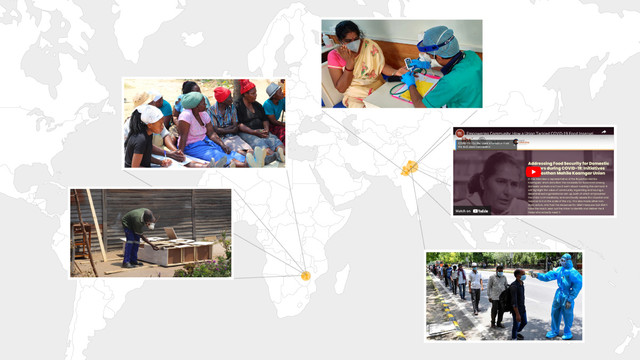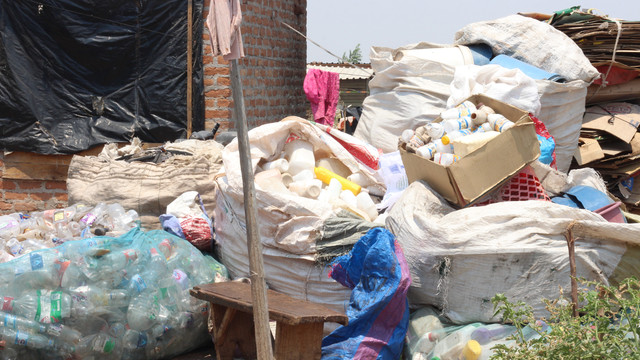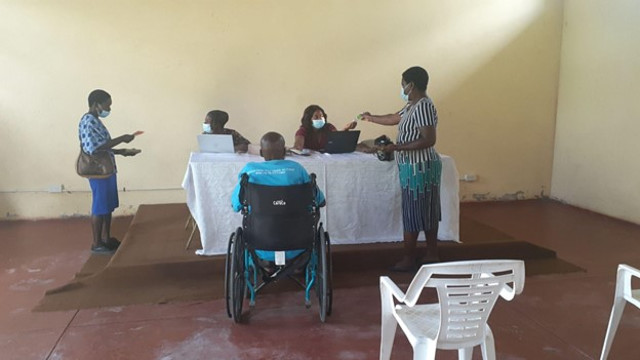New narratives for a 'new normal'
Sheela Patel and Suranjana Gupta report that women at the grassroots are generating practical responses to the coronavirus pandemic. Their effectiveness in this crisis highlights the importance of including grassroots women in climate change planning.



Members of DAMPA, a grassroots women’s federation in the Philippines, organising food distribution during the coronavirus pandemic. (Photo: copyright DAMPA)
Megan Rowling of the Thomson Reuters Foundation deserves at least half the credit for this piece. In a recent webinar on how grassroots groups are responding to the coronavirus, she called us out for using the ‘same old tired narratives’ presenting women as either ‘vulnerable’ or as ‘active agents’, leading us to reflect on why we use this language and to unpack some of the ideas behind these words.
Having worked with many grassroots women’s groups hit by major disasters, the Huairou Commission has seen repeatedly how organised grassroots women have dealt with disasters to get communities back on their feet. For instance:
- In the most remote parts of Honduras, where no assistance reached communities for days after Hurricane Mitch, indigenous women fed their families bread made of an indigenous root that survived the floodwaters. The same group went on to create seed banks to revive indigenous crops and agricultural tool banks to restore farming.
- In Turkey, earthquake-hit women monitored relief distribution and negotiated to improve sanitation and food in relief camps. They went on to organise women’s cooperatives that now run a country-wide network of women and children’s centres.
- In India, grassroots women in earthquake-affected areas became communication assistants to the government, going door-to-door disseminating information on the housing reconstruction programme, and reported back to government on implementation problems.
- In the Philippines, grassroots groups hit by Typhoon Haiyan initially monitored relief distribution in partnership with the national government and later created housing tool banks jointly managed with local government.
For nearly two decades now, Huairou Commission has supported hundreds of grassroots leaders from many countries – including Honduras, Jamaica, Turkey, India, Uganda, Zambia, Indonesia and Philippines – to travel within and outside their countries sharing practices, mentoring and advising their peers on reducing impacts of disaster and climate change.
What’s more, such exchanges have attracted the attention of local and national government agencies, getting them to recognise and legitimise grassroots women’s organisations.
At policy forums (particularly those focused on reducing disaster impacts), despite leadership roles played by grassroots women, they were conspicuously absent and persistently described as a ‘vulnerable group’, alongside children, the elderly and the disabled.
Paradoxically, women are caregivers to the other three groups. Like women, each of the other three groups offers valuable insights to address crises.
Despite the problems with bundling the four groups together, it has helped humanitarian efforts to considerably step up their responses to the special needs of these groups. But their narratives around vulnerability and responses to them essentially remain short term. They rarely examine the processes that impoverish and weaken the capacities of communities to withstand the onslaught of disasters in the first place. And the predominant narrative remains one in which women are cast as a vulnerable group, placing grassroots women-led scalable solutions in policymakers’ blind spot.
Promoting networks, partnerships and recognition
Social movements like the Huairou Commission, Slum Dwellers International (SDI) and WIEGO have consistently challenged this perspective. Years of investment in grassroots women’s movements have steadily built on grassroots initiatives – refining their practices, scaling them up through peer exchanges and government engagements – persuading governments to listen, learn and partner with grassroots organisations.
Can the COVID-19 crisis be an opportunity to mainstream such partnerships? Can the new normal we envisage turn grassroots-government partnerships into the ‘rule’ rather than the exception to it?
Grassroots movements play a critical role in collectivising grassroots groups through peer exchanges. Exchanges allow grassroots women to share practical knowledge, tell stories and build solidarity and even demonstrate how their leadership is recognised by local government.
This process of aggregation gradually elevates accidental initiatives, turning them into innovations which then coalesce to become scalable solutions. The consolidation of each solution lays the foundation for the next set of explorations.
Where there are responsive administrators or politicians, grassroots-government engagements can create an upsurge of collaborative action, pulling together grassroots and state resources to make concrete improvements in the lives of the poor, dramatically changing how women are perceived.
This kind of transformation, however, takes time. It can’t be accomplished through three-year projects. Resilience investments need to be long term. They have to produce a diversity of solutions to counter multi-generational deprivation and negligence that endangers the lives, livelihoods and wellbeing of economically and socially marginalised communities.
It is therefore vital to sustain community networks and maintain their visibility as drivers of development. As movements and networks gain public recognition, they are able to attract an array of allies, expanding their reach to ensure that new investments produce lasting changes in the everyday lives of poor communities.
How grassroots women are delivering pandemic responses

The organisation Swayam Shikshan Prayog is taking action to improve the resilience of rural communities (Photo: copyright Swayam Shikshan Prayog)
Grassroots organisations’ responses to the COVID-19 pandemic are building on years of organising, learning and collective problem-solving. When governments announced lockdowns, grassroots women acted swiftly, putting to work their relationships with each other and with government; and drawing on collective resources built over time.
- In the Philippines, grassroots leaders reached out to their networks in 24 rural barangays (districts) to disseminate information to educate communities on COVID-19. In informal settlements in the national capital, women-led water cooperatives used their savings to buy food for distribution.
- In Nepal, women’s cooperatives coordinated with local governments and municipalities to distribute relief and community resilience funds managed by women’s cooperatives were drawn upon to give livelihoods restoration loans.
- In India, women’s federations worked with village councils to distribute relief. They surveyed villages to identify those most in need of assistance and have already supported more than two thousand households to claim government entitlements. As early as March 2020, predicting food shortages, grassroots women encouraged their peers to plant vegetables. Three months later, vegetables from kitchen gardens are ensuring that families have nutritious food.
- In SDI federations in several countries, including India, Kenya, South Africa Nigeria, Malawi and Zimbabwe, explored many possibilities based on stories of mask-making, soapmaking, quarantine management and food distribution – exchanged by their peers.
Are grassroots women driving these initiatives also victims of the crisis? Are they vulnerable to discrimination or exclusion?
Of course they are. But as movements focused on empowering grassroots women, we choose to emphasise grassroots women’s leadership as the foundation upon which their collective power is built.
When women are classified as ‘vulnerable’ they tend to become disempowered voiceless entities, excluded from decision-making. When we see grassroots women as drivers of change, we turn the spotlight on their innovations and contributions. And we can clearly see the value of involving them in public planning and decision-making.
So whether it is managing the COVID-19 crisis today or forging new pathways to adapt to the changing climate, shifting the narrative to focus on grassroots women’s agency is already a crucial step in the right direction of constructing new narratives for a new normal.



